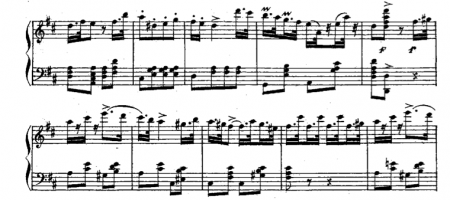
A short but apposite entry today, because I’m off to record a whole bunch of examples of exactly what this post is about: music for that kind of sissonne exercise that demands a slow, marchy kind of 2/4 that, you know, doesn’t sound too slow or marchy. Done well (as it always does when you’re playing for a company) the step looks fantastic – lithe, bouncy, strong, aerial, assured, elegant, noble.
It’s not the exercise that I dread, but the fact that once I’ve exhausted the two OK-ish bits of music that still sound more or less like music, I’m going to have to start improvising. Given the speed, rhythmic structure and tempo of the exercise, and my lack of ideas of how to make it musically interesting, what will come out will almost certainly be a stream of limp, diatonic drivel.
Boring but useful: the uses of diatonic drivel
To some extent, if what you’re playing has the right tempo, rhythm and feel, and the class is in the mood to jump, then a bit of diatonic drivel can be forgiven: you’re at least providing them with the structure within which to jump, and that’s better than sounding clever or entertaining, but at the expense of the exercise. Unfortunately, though, I know too much: I’ve seen the faces light up when you finally find a good tune; I’ve heard a principal say how much she loves it when she finally hears something she knows. So my anxiety is that you’re just boring these poor people to death with your improvising, yet you can’t think of anything else to play.
There’s no need to say “Oh but Jonathan, I’m sure what you play is fine,” because I know other pianists have the same anxiety. One told me that before a live TV broadcast of a class, she begged the teacher to try and steer away from that kind of 2/4, for precisely this reason. In the heat of the moment, no doubt as a result of nerves of her own, the teacher didn’t. I’m sure nobody really noticed that much, but for you as the pianist, it’s a horrible, sinking feeling as you have to keep playing stuff that you know is dull, but you’ve got nowhere to hide, and no time to think of anything better.
La Favorite: not my favourite music, but it’ll do for a 2/4 sissonne
There’s a variation in the ballet to Donizetti’s La Favorite that always seems to work well for this, and is the rhythmic model that I use for searching for other pieces, though even better is one that has accents on the offbeats, like one variation in Dom Sebastian (also Donizetti) that I can’t find right now. Things like Stairway to Paradise just about fit the model, and just about work, but somehow, there’s something about these old ballet variations that have the right amount of air, strength and ballon in them, and it’s very difficult to find something different unless it’s just a pastiche of the same style. Maybe part of the problem is that it really has to be in 2, not 4, that is, with a good solid accent every two beats, not with a half-accent in the middle of a 4/4 bar. In the Donizetti example illustrated, despite appearances suggested by some of the accompaniment (bass + 3 equal chords), the melody, and most of the harmonic changes, suggest that this is another case of compound duple, i.e. two bars of 2/8 combined for notational convenience into 2/4, but it’s not “4/8” in the sense of having a half-accent in the middle of the bar (see earlier post for more).
The alternative is for the teacher to put it on a 3 instead, but to be honest, it never seems to work as well. The 2/4 sissonne is just one of those ballet problems that you have to solve somehow, and I’m still trying.


Hello again Jonathan! You are right, it does not work so well on a 3/4. I like the 2/4 because it a strictness and boxiness that makes the following 3/4 grand allegro feel all the more free flying!
What a great explanation. We should write a book… !
Interesting ! Still, russians tend to use 3/4 for sissonnes, be them sissones ouvertes, sissonnes fermées or grands sissonnes ouvertes, of course it depends in the technical execution of the step… Or maybe it is because I’m more biased towards female teaching, because male variations are always 2/4 when it comes to big sissonnes jumps.